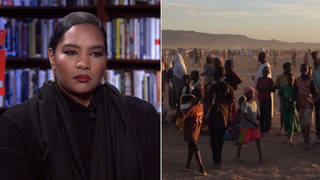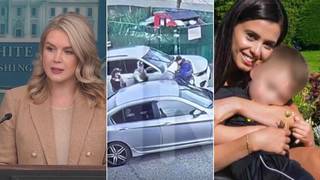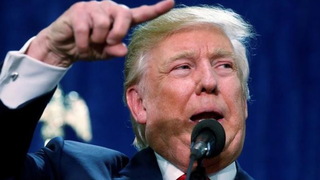
Guests
- Carol Andersonprofessor of African American studies at Emory University. She is the author, most recently, of White Rage: The Unspoken Truth of Our Racial Divide.
Jury selection has begun in two high-profile murder trials of white police officers who killed unarmed black men. In Ohio, former University of Cincinnati police officer Ray Tensing shot and killed 43-year-old Sam DuBose last year after stopping him for not having a front license plate. In North Charleston, South Carolina, officer Michael Slager faces a murder charge after a bystander filmed Slager shooting 50-year-old Walter Scott in the back as he ran away. For more, we speak with Carol Anderson, professor of African American studies at Emory University. She is the author, most recently, of “White Rage: The Unspoken Truth of Our Racial Divide.”
Transcript
AMY GOODMAN: Your book is called White Rage: The Unspoken Truth of Our Racial Divide.
CAROL ANDERSON: Yes.
AMY GOODMAN: Talk about the white rage that you’re witnessing today.
CAROL ANDERSON: That rage covers itself. So, when I talk about white rage, I don’t actually mean the Klan and the cross burning, because that’s simple. In this society, we know how to identify that. This is the much more subtle, the much more destructive type of racial violence. And it emanates out of Congress, out of the Supreme Court, out of state legislatures. And it’s designed to, in fact, undercut black achievement, black aspirations and black advancement.
So we see that, for instance, with—when Trump, at the presidential debate, and they said, “Well, how would you handle issues of racial healing and the racial divide?” and he said, “I’ve got words that somebody refuses to say, and that’s 'law and order,' and that’s 'stop and frisk.'” That is a dog whistle. That is—those are policies that, in fact, undermined the Civil Rights Act of '64 and the Voting Rights Act of ’65, has led to mass disfranchisement, so that you've got almost 8 percent of the black population unable to vote.
AMY GOODMAN: Let’s go to Donald Trump in North Carolina instructing security guards to remove a black man from the crowd, describing him as a thug.
DONALD TRUMP: You know the great thing about that—we have a protester. By the way, were you paid $1,500 to be a thug? Where is the protester? Where is he? Was he paid? You can get him out. Get him out. Out.
AMY GOODMAN: While Donald Trump described the man as a protester, it turned out he was actually a Trump supporter. Sixty-three-year-old C.J. Carey said he went to the rally to give Trump a letter. Professor Anderson?
CAROL ANDERSON: Yes, and it begins to tell you that—so, for all of Trump’s outreach to the black community, there was no outreach. The point was, is that his racism was so palpable that it was turning off white educated voters, and so he tried to smooth that edge. But, in fact, the racism that is undermining—undermining, but undergirding, his campaign is there, so a supporter is immediately a thug. So, a black man is immediately criminalized as thug. And this is a businessman who is a Trump supporter. And that gives you some sense of the kind of perspective, the policy perspective, that Trump will enact if he becomes president.
AMY GOODMAN: What were you most surprised by as you researched White Rage?
CAROL ANDERSON: I was surprised by how consistent and supple white rage was, how it consistently used the language of democracy, the language of freedom, the language of protecting the integrity of the ballot box, as a means to undermine and undercut. So, we get not only the Shelby County v. Holder, which gutted the Voting Rights Act, but we also get, for instance, in the Brown decision, where the Supreme Court has said “separate but equal” cannot be the law of the land, and watching these people who say that they are inherently about democracy, in fact, undermining that democracy by violating court orders consistently, over and over again, kind of like what we’re seeing right now as the Fourth Circuit, for instance, has told North Carolina, you know, “Your voter suppression laws can’t stand,” and they keep doing it.
AMY GOODMAN: I wanted to ask you about other developments this week. Jury selection began on Monday in two high-profile murder trials: white police officers who killed unarmed black man. In Ohio, the former University of Cincinnati police officer Ray Tensing shot and killed 43-year-old Sam DuBose last year after stopping him for not having a front license plate. And then there’s the case in North Charleston, South Carolina, officer Michael Slager facing a murder charge after a bystander filmed Slager shooting 50-year-old Walter Scott in the back as he ran away. In that case, Walter Scott was stopped by the police officer as he was driving into the AutoZone shop right nearby for, I think it was, a broken taillight. He was stopped for the taillight, and he ends up being shot by the police officer.
CAROL ANDERSON: Yes, yes, yes.
AMY GOODMAN: The trials come as a Justice Department investigation into the choking death of unarmed African American Eric Garner by New York police officer Daniel Pantaleo is in disarray. The New York Times reported last week that the New York-based FBI agents and federal prosecutors are no longer assigned to the investigation. They did not feel Pantaleo should be charged. The shake-up leaves prosecutors with the Justice Department’s Civil Rights Division in charge, making it far more likely officers will face criminal charges.
CAROL ANDERSON: And part of what we’re seeing right here is the policy of stop and frisk, which came after the advances of the civil rights movement. And so, stop and frisk is based on the broken windows theory of policing. And it says, what we have to do—if we stop these little minor crimes, then we can really stop the big ones form happening. But that’s not what really goes on. In fact, you get the criminalization of blackness. In New York City, for instance, although blacks and Latinos made up 50 percent of the population, they accounted for 84 percent of those stopped, although twice as many weapons were found on the handful of whites that were stopped as opposed to blacks and Latinos. And so, if this was really about law enforcement, you would see greater policing of the white population. This is about something else. And so, what we’re seeing in the case of the broken taillight, in terms of the expired tag, that’s that hyperpolicing that’s going on because of stop and frisk, and it leads to the death of black people.
AMY GOODMAN: You have linked the problem with policing today to education.
CAROL ANDERSON: Yes.
AMY GOODMAN: You say we wouldn’t face anything like this today, if what?
CAROL ANDERSON: If Brown had really been implemented. Because part of what we know is that what a solid, quality education does, in terms of employment, in terms of health, in terms of voting rights—all of those things are really linked to education. But Brown—after Brown, the states fought back so intensely, even to the point where they shut down a public school system for five years. And so, it’s like you were in school at the fifth grade, and your school doesn’t open again until you’re in the 10th? And the states fought back so hard that we’re ending up with large numbers of African Americans who do not have the quality education that they have a constitutional right to. And so, now we’re asking the police force to then deal with those issues emanating out of poverty, emanating out of the lack of quality education.
AMY GOODMAN: What do you see—how do you assess President Bill Clinton’s administration when it comes to issues of white rage, black disempowerment, black empowerment, and then Hillary Clinton?
CAROL ANDERSON: So, for Bill Clinton, part of what I see is that he went the route of the Southern strategy, which was to play to the blacks as criminals. And this is where you see—and blacks as welfare cheats. And so, this is where you see his workforce legislation. This is where you see the kind of hyperpolicing with superpredators and all of that. And this led—again, it fed into the mass incarceration of the black population. Now, what Bill Clinton would do is he would try to play culturally black—so that was, you know, the saxophone on Arsenio or all that—but the way that his policies worked were in fact very anti-black. Now, with Hillary, what I see is that she was there with him in the ’90s.
AMY GOODMAN: Well, let’s go back to that moment in 1996 when she was first lady, when she described some African-American youth as superpredators.
CAROL ANDERSON: Yes.
HILLARY CLINTON: They are often the kinds of kids that are called superpredators—no conscience, no empathy. We can talk about why they ended up that way, but first we have to bring them to heel.
AMY GOODMAN: At CNN’s Democratic debate in Flint, Michigan, earlier this year, Clinton was asked about her comments again.
DON LEMON: Secretary Clinton, in 1996, you used the term “superpredators” to describe some young kids. Some feel like it was racial code. Was it? And were you wrong to use that term?
HILLARY CLINTON: Well, I was speaking about drug cartels and criminal activity that was very concerning to folks across the country. I think it was a poor choice of words—I never used it before, I haven’t used it since, I would not use it again.
AMY GOODMAN: So, that was Hillary Clinton. That was during the primaries, when she was debating Bernie Sanders. Your comments, Professor Anderson?
CAROL ANDERSON: My comments are that when I see that, it’s like Hillary was, in that moment in 1996, right along with Bill, and now that she realizes that the demographics in the Democratic Party have changed, that that coding doesn’t work as well, it doesn’t play as well, and so you see her stepping back. And I think part of what I’m also seeing, frankly, has been the pushing on that from the Black Lives Matter activists, who are helping her—and the Bernie folks, who are helping her begin to see what structural racism actually does in this society. So, in fact, when she mentioned—I think it was in the—one of the presidential debates, that we have to deal with structural racism, that was a major leap forward. But that requires then consistent pressure consistently be put on her to deal with what that really means policywise, so it can’t just be a slogan that gets dropped during the presidential campaign.
AMY GOODMAN: Well, Carol Anderson, I want to thank you very much for being with us. Carol Anderson is professor of African American studies at Emory University. Her new book is called White Rage: The Unspoken Truth of Our Racial Divide. When we come back from break, we go to Iceland to speak with the poet and activist Birgitta Jónsdóttir. She is co-founder of the Pirate Party, that made major gains in Iceland. That’s the anarchist party of Iceland. Stay with us.













Media Options